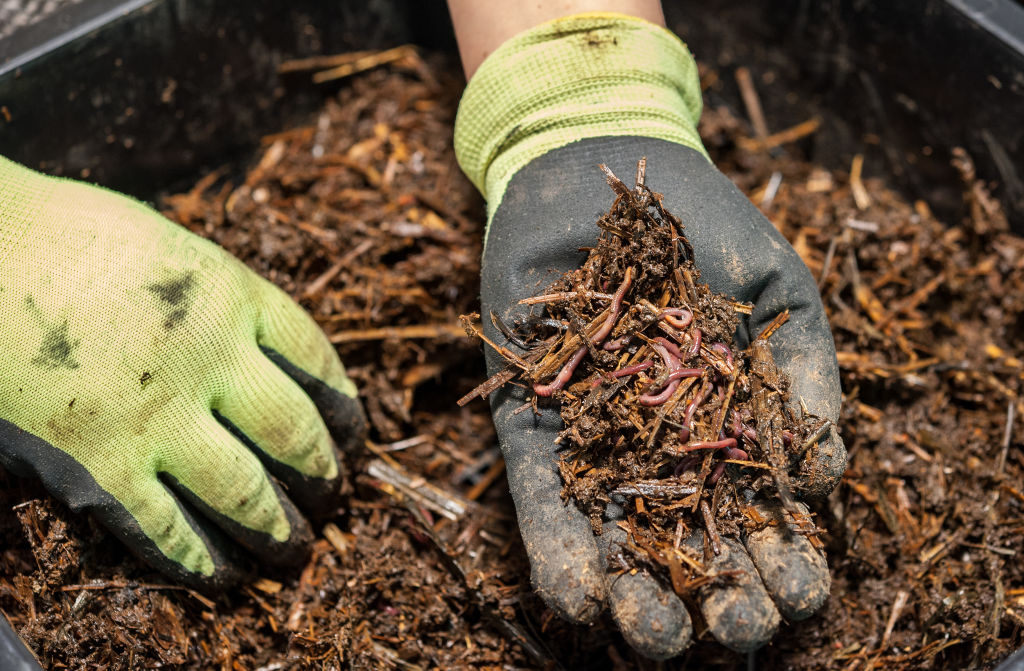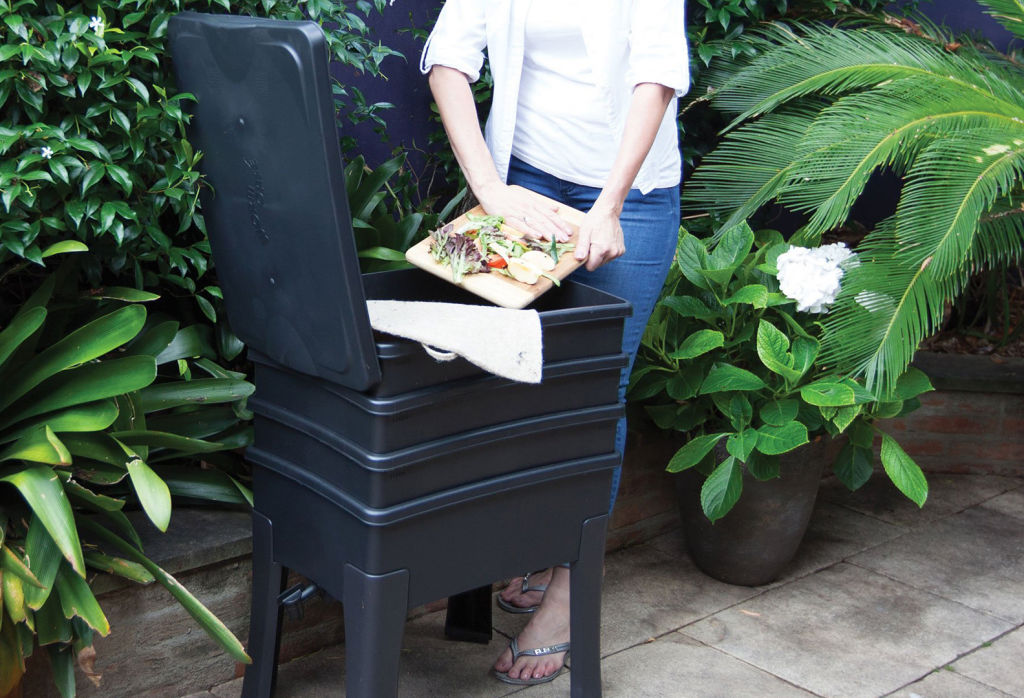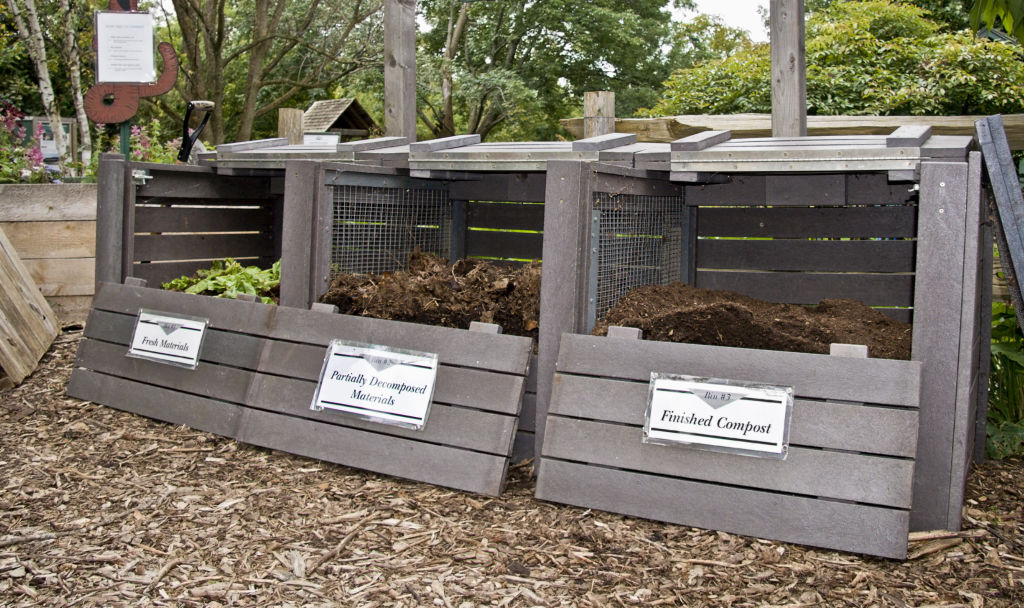How to compost kitchen scraps if you rent or live in an apartment

Composting is a smart way to dispose of kitchen waste while creating nutrient-rich matter to feed plants organically.
But if you rent your home, live in a small apartment, or you’re short on space, a traditional compost heap or bin might not be an option.
Fortunately, there is a small-scale alternative. Nature’s waste recyclers – composting worms – can be harnessed to keep organic waste out of landfill, reduce your carbon footprint and create rich fertiliser, all without upsetting your landlord.
How worm farming works
A worm farm usually consists of a series of elevated trays on legs. At its most basic, a worm farm has a top “working” tray, a bottom “collector” tray featuring a tap to collect the liquid runoff, and one or more additional trays for removing the compost.
Worms in the working tray in bedding, generally made from damp coconut fibre or shredded newspaper. It’s also where they are fed scraps from the kitchen.
As worms digest food, they create castings – also known as vermicast – and a liquid known as leachate, which drains into the collector tray through holes in the working tray.
Most home worm farms take up less than a quarter of a square metre and are suitable for small balconies and courtyards.
Off-the-shelf kits contain everything needed to get started, except the worms, which are sold separately. Expect to pay from $70 for a worm farm and $50 for a starter pack of about 1000 worms.
A well-functioning worm farm won’t smell, apart from a pleasant earthy aroma, and if kept closed, vermin won’t be able to get in and worms won’t be able to get out.

How to feed the worms
To feed the worms, place kitchen scraps on top of the worms’ bedding in the working tray.
Once established, worms can consume their weight in food each day. Depending on the size of the worm farm, the number of worms and the temperature, about one to two handfuls of kitchen scraps each day is sufficient.
Matching the volume of waste to the number of worms is the biggest worm farming challenge, according to Angus Stewart, horticulturist and ambassador for worm-farm-maker Tumbleweed.
“When people are starting out they often overload their worm farm with kitchen scraps, and that overwhelms the small worm population,” he said.
“That’s when it starts to smell because the worms physically can’t process the amount of waste that is being dumped onto them.”
Stewart says it can take some weeks for worms to acclimatise to their new environment before they can handle the amount of kitchen waste a typical household generates.

How to collect the fertiliser
The compost and leachate produced by worm farms are rich in microbial life and continues to enhance garden soil over time. It’s also extremely potent and should be used in moderation to avoid damaging plants.
The liquid can be accessed using the tap in the collector tray, diluted with water at least 10 parts to one, and used to feed plants.
To access worm castings, wait until the tray is full, which will take several months. Stop feeding the worms for about a week, then add one of the extra trays to the top of the system and fill it with bedding.
When scraps are placed into the top tray, the worms will migrate through the drainage holes to find the food. After several days, most of the worms will have left the original working tray, which can then be removed and emptied of castings.
Castings can be mixed into the soil when preparing a garden bed or pots for plants.
Community composting
If you’re keen on composting, but baulk at the idea of keeping thousands of worms on your balcony, there’s another option.
ShareWaste is an app that connects people who want to compost but lack the means to do so, with neighbours who have a compost bin or worm farm and are willing to accept waste. Composters post their location, and donors can get in contact and organise a drop-off.
ShareWaste founders Eliska Bramborova and Tomas Brambora started the app after finding it difficult to compost at their rental property.
“We were just horrified by the amount of organic waste that just went straight into our garbage bin,” Bramborova said.
“It’s pretty much the only waste that doesn’t need to be waste because people can compost it. For all other types of waste like plastic and paper, you need a commercial facility to recycle it.”
Bramborova said the benefits of shared composting go beyond waste reduction.
“It also connects neighbours on a community level,” she said. “A lot of our donors and hosts become friends. They don’t just share waste, they share their garden produce, skills and knowledge.”
If there are no hosts in your area, contact your local council to find out if there is a community garden nearby that will accept food scraps.

Top 7 worm farming tips
1. Avoid overfeeding, especially when the farm is still being established. Wait until almost all the food is digested before adding more. You’ll soon notice how much the worms can eat so you can feed them accordingly.
2. Avoid acidic foods, such as citrus, onion or garlic, as well as meat, dairy, fats and oils.
3. Cover worms with damp hessian, newspaper or a specialised worm blanket to retain moisture.
4. Prevent smells by controlling moisture and acidity. If the worm farm has an ammonia or vinegar smell, or there are tiny flies inside, it’s likely due to too much moisture, too much food, or not enough aeration. Stop feeding the worms for a while and add shredded newspaper or worm farm conditioner to restore the balance.
5. Keep worms cool in summer by keeping the farm in a shady spot that’s somewhat sheltered to avoid flooding in heavy rain. If there is too much moisture in the worm farm, the worms may try to escape.
6. Store scraps in the freezer or fridge in a sealed container. It reduces smells, which avoids the need to take the scraps out every day, and helps it break down faster. Be sure to thaw it out before adding it to the worm farm.
7. Chop scraps finely or blitz in a food processor before feeding worms. It allows them to process scraps faster.
What you can feed worms
- Fruit
- Vegetables
- Bread
- Pasta
- Crushed eggshells
- Tea leaves
- Shredded paper
- Tissues
What you can’t feed worms
- Meat
- Dairy
- Fats and oils
- Citrus
- Garlic
- Onion
- Leeks
- Capsicum
- Chilli
- Glossy paper
We recommend
States
Capital Cities
Capital Cities - Rentals
Popular Areas
Allhomes
More







